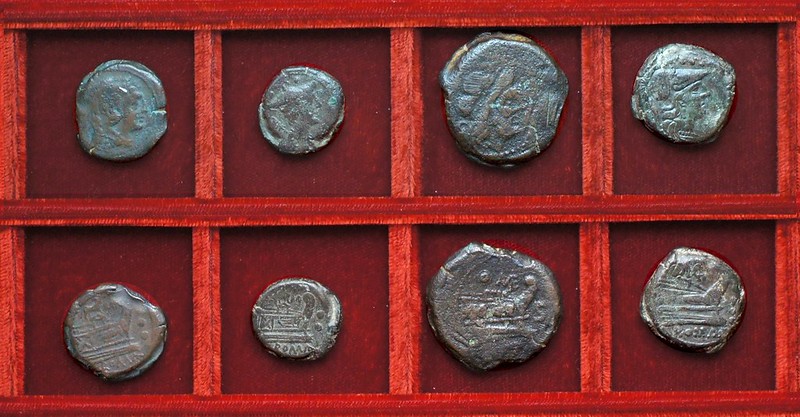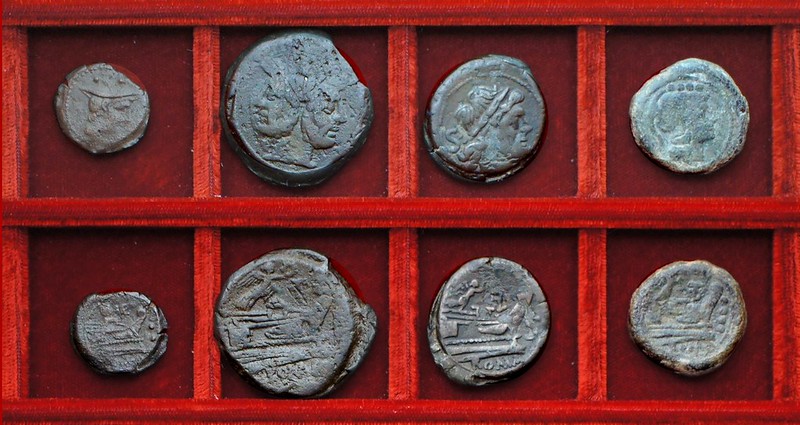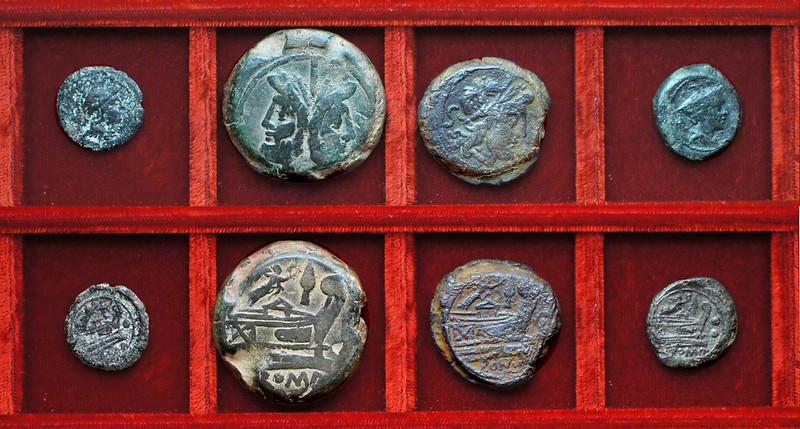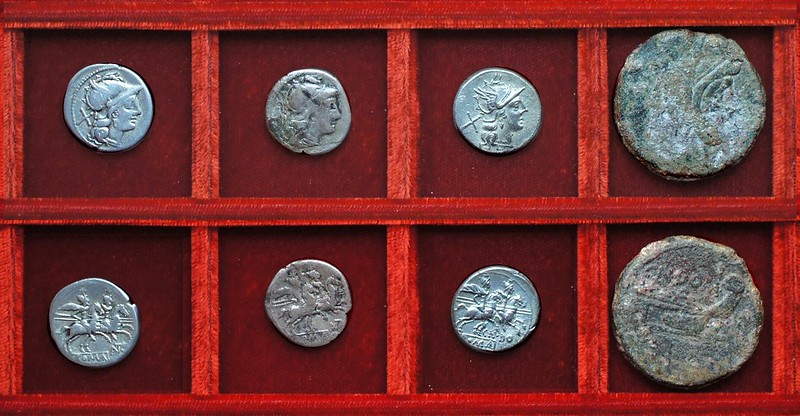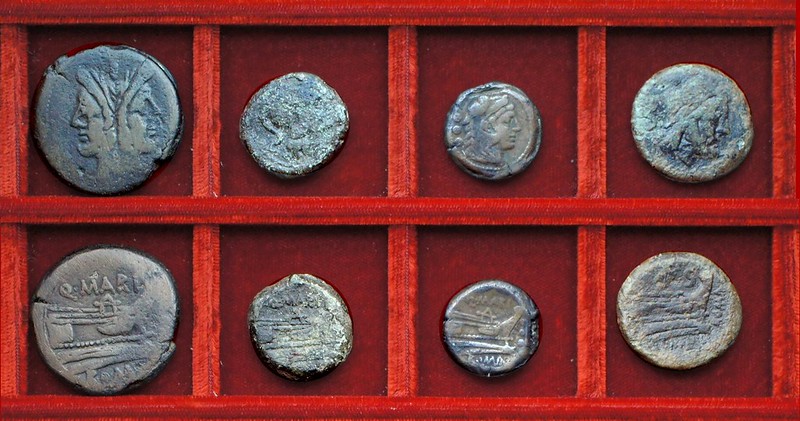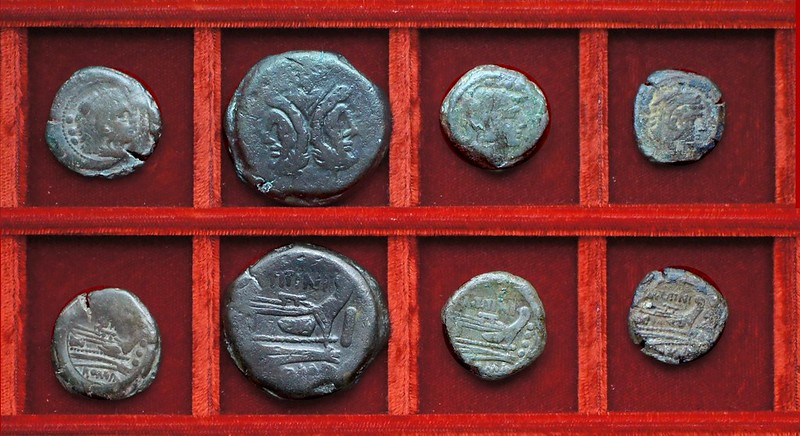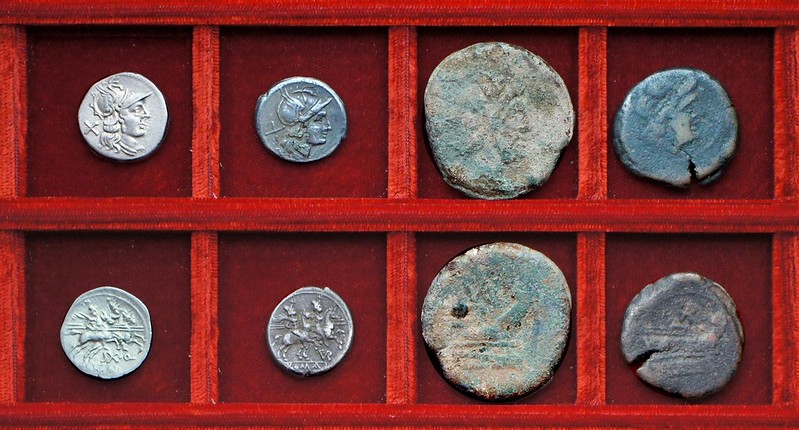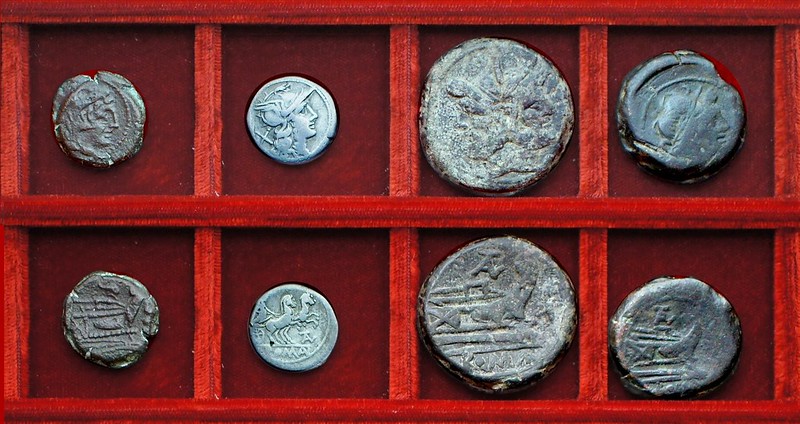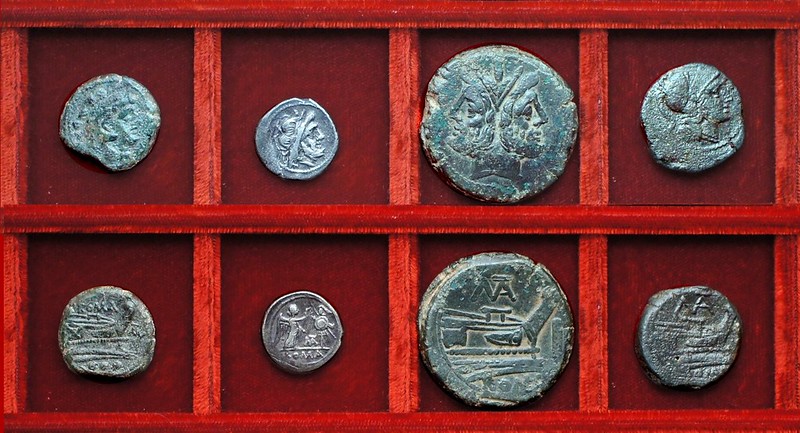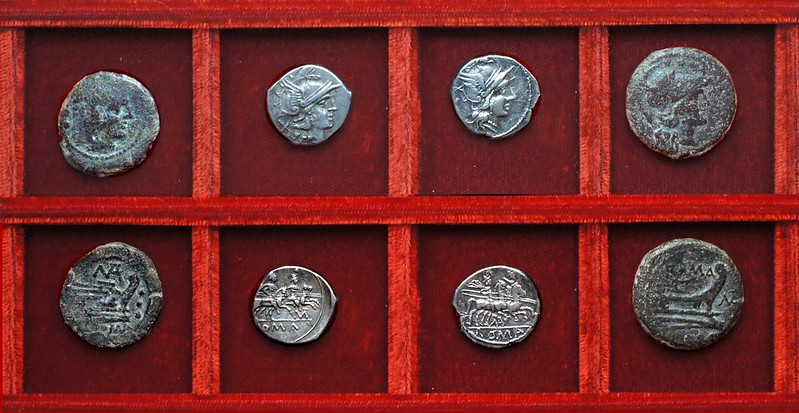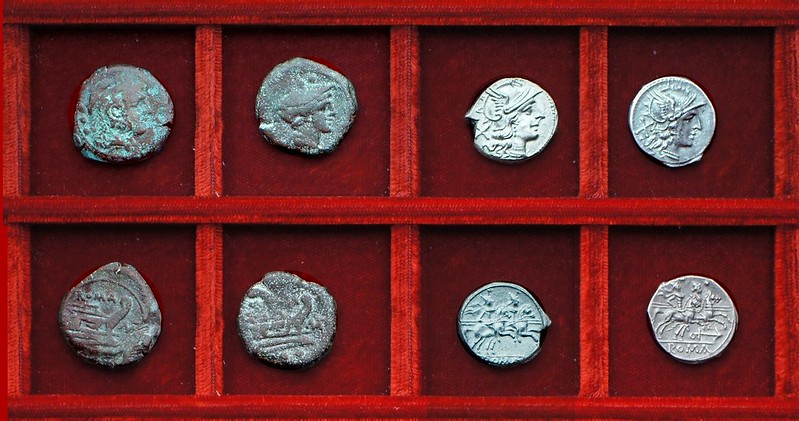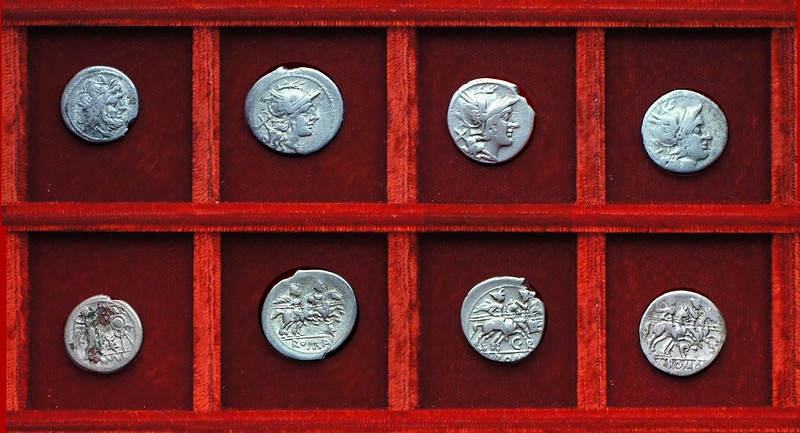Part 7 RRC 139 to RRC 172, 190BC to 170BC, Silver and Bronze, mint of Rome
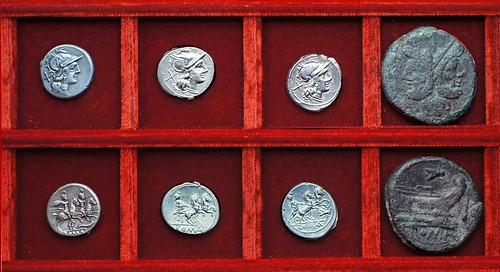
|
Specialist Supplements:
1. Roman Coins of Luceria and Canusium
2. Anonymous Struck Bronze Coins of the Roman Republic
3. Anonymous Roman Republican Denarii and Victoriati (Steve Brinkman's site)
Principal Coins of the Roman Republic
Part 7 RRC 139 to RRC 172, 190BC to 170BC, Silver and Bronze, mint of Rome
RRC 139 Dioscuri denarius, RRC 140 Luna in biga denarius
RRC 141A bird and TOD wren bronzes, RRC 141B eagle and wreath bronzes. Russo, in Essays Hersh, split the bronze coins of these issues into two entirely different types. The more common group show an eagle holding a wreath on top of a perch, and are unrelated to the 'bird and TOD' denarius. The much rarer types show a wren on top of the letter T or on top of the letters TOD, and these are plainly related to the 'bird and TOD' denarius. The 'bird and TOD' As comes in two variants; some have a wren atop a letter T in front of the prow and the much rarer single-die variety has the wren atop TOD above the prow. The above example of this rare coin is perhaps the finest known. None of the three published specimens, in the Crawford plates, in Essays Hersh, and in the RBW sale NAC 61, have a clearly shown wren as this coin has.
RRC 141B eagle and wreath bronzes, RRC 142 bull and MD Durmia bronzes. It is entirely speculative what the letters MD stand for, but traditionally it has been taken to be Marcus Durmius.
RRC 142 bull and MD Durmia bronzes, RRC 143 shield and MAE Maenia bronzes. It was typical in this era to use paired symbols and family-name monograms. Prow styles vary a lot from issue to issue in this period, for example the shield and MAE types have a flat deck structure, whereas those on bull and MD are peaked, suggesting perhaps that each mint manager employed new engravers.
RRC 143 shield and MAE Maenia sextans, RRC 144 Victory and LPF Furia bronzes. This is another enigmatic monogram that is generally taken to be LPF, ending in F and thus probably Furia, rather than LFP.
RRC 144 Victory and LPF Furia sextans, RRC 145 Victory and spearhead bronzes.
RRC 146 AVTR Autronia denarii, RRC 147 CN.DOM Domitia denarius and As. I show two examples of the Autronia; the less attractive example at right comes from the Cabinet of Roman Family Coins belonging to His Grace the Duke of Northumberland, K.G., as published by Rear-Admiral William Henry Smyth, KSF, DCL, FRS, in 1856. This actual coin is described on page 22, number 8: QUOTE "This is a coin of the same deivce and fabric as number 7, but is much lighter, weighing only 37.3 grains (2.42 grams)); and it affords evidence in the minutiae of having been struck from another die. AUTRONIA (rank unknown): Obv — The winged-helmed head of Pallas Nicephora, with X at the back of it. A very rare denarius. Rev — The Dioscuri on galloping horses, with their lances couched; the stars over their helmets being strongly marked; under the animals is the monogram AVTR(onius), and on the exergum ROMA. Very little is recorded of this gens, the only family name of which is Paetus: a cognomen of course acquired by one who squinted, or was cross-jack eyed: indeed among numismatists it got confounded with the Sempronii, till rescued by Vaillant. The object of this type being of course to appear worthily in the eyes of posterity — "Oh, fond attempt to give a deathless lot, To names ignoble, born to be forgot!" UNQUOTE. It's listed by Fulvius Orsini (16th century) as a Sempronia - he assumed to be L. Sempronius Atratinus, the AVTR monogram being taken for ATR - but with no special comment on rarity. The coin is listed as Autronia, and as Rare by Echkel. It was certainly Echkel who changed the designation as he refers to prior authors having taken it for Sempronia. What if Orsini is right and the monogram is indeed ATR rather than AVTR? Mark Passehl commented that Echkel is probably right, because if you're going to monogram ATR in 2nd century Rome, you'd be more likely to superimpose the A and T, rather than T and R. Their separation within a monogram probably wishes to accomodate at least one more letter, whether Echkel's V or N or both. This is another great example of how numismatics is well-served by revisiting old designations and assumptions from time to time.
RRC 148 Q.MARI Maria bronzes, RRC 149 Ulysses L.MAMILI Mamilia semis. The Mamilia series with Ulysses is very complex, and the various varieties are under-represented in the Ahala collection, with the semis in this tray having Ulysses above the prow and L.MAMILI below; the quadrans in the next tray also has Ulysses above the prow but no family name. There are many varieties of the placement or absence of family name, placement of the word ROMA etc. across all denominations. All types are very rare.
RRC 149 Ulysses Mamilia quadrans, RRC 150 M.TITINI Titinia bronzes.
RRC 151 S.FVRI Furia bronzes, RRC 151B dolphin second series bronzes. This tray contains some of the least understood bronzes in the Roman Republican series. Only one of the four bronzes above is listed in Crawford, the triens of RRC 151 S.FV. Crawford rejects as tooled the British Museum example of the S.FVRI as, but an unimpeachable example is shown below, of the same dies as the above example. The dolphin second series is linked to RRC 151 S.FVRI by the distinctive prow style including the wide peaked deck structure that slopes down to the right, as well as by the form of prowstem. This cannot be RRC 80 nor RRC 160, thus this is an intermediate second dolphin series. It is not identified in Crawford RRC, nor in Russo, Essays Hersh, but Russo notes the series' existence in the RBW sale NAC 61 lots 671 (as) and 672 (triens). I show here an As and quadrans from this series.
RRC 151 S.FVRI Furia As. The discovery of this specimen in 2011 verified the perviously suspect British Museum example which is from the same dies.
RRC 152 SX.Q Quinctilia denarius, RRC 155 PVR ligate Furia denarius, As and semis. This PVR series with the monogram completely ligate, rather than with the P separate as in RRC 187, is of great rarity. The bronzes are only known in a few examples each, and the denarius is also very rare.
RRC 157 cornucopia denarius, RRC 158 Luna in biga denarius, RRC 159 fly denarius and As.
RRC 159 fly bronzes, RRC 160 dolphin third series bronzes. The third series dolphin bronzes are merely scarce; in comparison the fractions of RRC 80 and RRC 151A (see notes above) are all very rare. The As of RRC 80 is common, that of RRC 160 is less common, that of RRC 151A is extremely rare.
RRC 160 dolphin quadrans, RRC 161 TAL Juventia denarius, bronzes.
RRC 161 TAL Juventia quadrans, RRC 162 MAT Matiena victoriatus, As and triens (thick letters). The silver and bronzes of RRC 162 justify further study. The bronzes appear to split into two groups by style; the fractions with MAT before the prow have slender lettering that matches some Asses, denarii and victoriati. The fractions with MAT above the prow have thick straight-line lettering that matches the As, triens and victoriatus above. Perhaps there are two separate series within; perhaps there are merely different engravers.
RRC 162 MAT Matiena quadrans (thick letters), MAT denarii and triens (slender letters). The denarius with MAT comes in a variety of irregular styles, two of which are shown above.
RRC 162 MAT Matiena quadrans and sextans (slender letters) RRC 164 Dioscuri denarius, RRC 165 anchor denarius. The MAT sextans is of an untypically large diameter for coins of this period. It weighs 6.43 grams, which is also heavy for the era. In style it matches the other fractions with MAT before the prow.
RRC 168 helmet victoriatus and denarius, RRC 169 GR Sempronia Gracchus denarius, RRC 170 ear denarius. Crawford groups together ten silver issues between RRC 163 and RRC 172 and places them prior to 170 BC. Given the preponderance of bronze issues from 200 BC to 150 BC, and the lack of recorded hoards of bronzes, evidence for dating remains very limited. Following these issues it seems that Rome entered a period of 15 or perhaps 20 years in which no silver coinage at all was struck apart from the small RRC 182 gryphon issue.
RRC 171 D denarius.
Specialist Supplements:
1. Roman Coins of Luceria and Canusium
2. Anonymous Struck Bronze Coins of the Roman Republic
3. Anonymous Roman Republican Denarii and Victoriati (Steve Brinkman's site)
All content copyright © 2004-2013 Andrew McCabe unless otherwise noted. If you've any questions or comments please contact me on the Yahoo Group RROME: http://groups.yahoo.com/group/RROME.
Alternately you can leave comments against any coin picture, just click on the picture and write in the comment box.
Site hosted free courtesy of VCoins.com
Ancient Coins on Vcoins
comment: this page is RRC139.html









